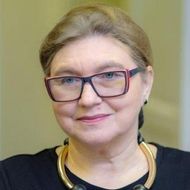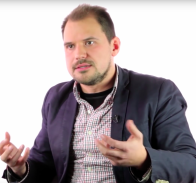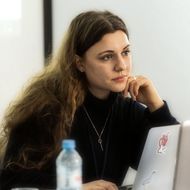'We Shape HSE University Community Through Inter-Campus Courses'
Inter-campus courses are the subjects that are available online for students of all HSE campuses. The courses have been present at the university since 2020, and during this time have become an integral part of the educational process. In this post, we will take a look at their main features and advantages.

Students from different campuses of HSE University — in St. Petersburg, Moscow, Perm, and Nizhny Novgorod — coincide during inter-campus courses. This way, those enrolled in programmes in St. Petersburg can attend courses held by teachers in Moscow or Perm, and vice versa. Some may want to attend classes in another campus to see in which way they different from what they are studying right now.
As for the educational process, it has changed due to the implementation of inter-campus courses. HSE University’s campuses now share a common grid of classes: it takes into account a time difference with Perm. Thus, students may coincide with each other when attending double classes online.
This practice of implementing an intercampus format is also applied to minors and MAGOGOGO, which are additional educational trajectories offered for HSE University students.
In general, inter-campus courses are designed to improve the quality of education at the university and develop the scientific environment. As a result, students acquire new acquaintances and gain additional knowledge. We asked lecturers at HSE – St. Petersburg to tell us what are the benefits of implementing an inter-campus format of education.
Mark Zaslavskiy, conducts the inter-campus 'Mobile Development' course

I have been giving lectures on 'Mobile Development' for several years, and, in my opinion, implementing inter-campus practice has positively affected the quality of teaching. The need to switch to distance learning made me take a different look at the preparation process, as well as at the methods of passing the subject’s milestones. In such conditions, it is necessary to clearly outline the tasks and criteria of students' knowledge assessment, as well as prepare materials in the most intuitive way.
The course was originally designed as a problem-based learning one. Students have to master the subject working in groups on a semester project, which is based on a real market need or on the idea suggested by the team. The goal of the project is to create a workable mobile application that would take into account the end user’s preferences and aims. At the same time, the development process is connected to and depends on the course’s structure—from generating the idea and user interface to the implementation and coding. This allows reducing possible risks, as well as increasing the mobile app’s attractiveness to the end user.
In the classroom, together with students, we analysed materials on the life cycle of mobile applications. We also discussed in detail each team's projects, studied handy examples, and discussed how to implement certain elements into the application.
A significant advantage of this new teaching practice is that it allows making the work on the project less routine and more creative. Before that, teams of students used to communicate once a week and during this short period of time they had to hand over results of their work. Together with my students, we managed to build a more lively and dynamic studying process in which I played the role of a customer who ordered a mobile application, and they were the development team. This allowed me to immerse myself in the field of study.
Elena Kudriavtseva, conducts the inter-campus 'Communications in Business' minor

Our minor brings together students from all HSE University’s campuses. It is very popular, so seats are booked in one day. Students from various fields of study attend the course’s lectures: philologists, mathematicians, lawyers, and economists.
At the beginning of an academic year, we try to form study groups in such a way that they include students who come from a similar area of study. This helps students to 'speak the same language' during the classes. For example, mathematicians need more time to understand material that is already familiar to economists. But there are mixed groups as well, which include lawyers, economists, and specialists in public administration. Exchanging experience helps students get a better understanding of the subjects.
During our course, students attend lectures, seminars, and project classes. At lectures, they study the theory, at seminars go through the most frequently asked questions and revise the studied material. And at project classes, they are taking part in practice-oriented tasks. Using examples, we show how different communication tools can be used for promotion: for one’s personal image, ideas, or in order to solve marketing tasks.
The advantage of such courses is that students can attend lectures conducted by teachers from different campuses. For example, we have many students from Moscow who revealed to us that they deliberately decided to pick minors in St. Petersburg to see in which way the study material is different and how everything is arranged here.
I would say we shape HSE University Community through inter-campus courses. Even if there are representatives of similar areas of study in the same group, the whole environment is different, since students travel to other campuses. It is great to see that during the courses students start communicating with each other on personal and professional issues, making new friends. No doubt, for them, the university is a perfect place for networking.
Maxim Demin, conducts the inter-campus 'Philosophy' course

Last year I gave lectures on a course called 'Argumentation and Critical Thinking'. This is a combination of online classes, pre-recorded lectures and online tests. It is supposed that students are free to decide at which time during the week they should watch video lectures and take the tests. At online meetings, I highlight the most significant parts of the study material, share new research, and at seminars we discuss and revise the material.
The intercampus format of teaching has significantly expanded the course’s audience. Thus, students of different educational programmes and ages are welcomed to participate in seminars. I find such diversity inspiring. When teaching critical thinking, it is important to involve people who can offer different perspectives on the same subject.
Alexandra Pakhomova, conducts seminars at the inter-campus 'Semiotics of Culture' course

I have the most positive impressions from teaching this course in an inter-campus format. This time in one group we gathered students from different faculties and fields of study.
Of course, organizing the educational process on an inter-campus course is more difficult, since a teacher has to simultaneously involve both students present in the classroom and those who participate online. Still, despite the fact that this hybrid format seems to be difficult at first, once the pattern is worked out, it is easy to get used to it.
The course 'Semiotics of Culture' allows students to get acquainted with the main methodological tools of semiotics, with the scope of its application. It gives a chance to apply certain semiotic constructions in one's scientific work. Apart from that, this course introduces students to the history of the development of the humanities in the twentieth century. I believe that this background knowledge can be leveraged by students of many fields of study—philology, sociology, media, among others.
Seminars were held in a hybrid format: some students attended lectures in the classroom, others took part online. Besides, when students could not attend classes in any of the mentioned formats for some reasons, they were given a task to prepare written answers to the questions discussed at the seminars. Each student has a different schedule, and it is hard to find a time that will be convenient to everyone. It is important for us to give each student a chance to share thoughts and ideas.
Gathering students from different campuses allowed us to expand the topics for discussion and consider different points of view. The semiotics of culture is a vast field, and in order to get a better understanding of it, one must take into account different personal experiences and scientific backgrounds. To achieve this, implementing inter-campus courses will be just a perfect option.

